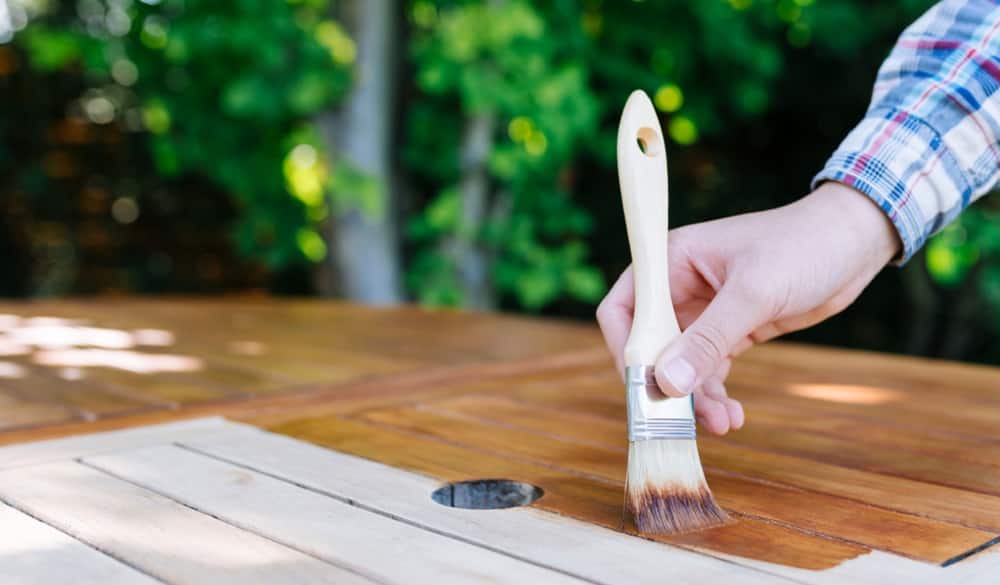What is teak oil – is it food safe?
Woodworking is a timeless craft that has captivated artisans and hobbyists for generations. Whether you’re a seasoned woodworker or just getting started, one essential aspect of working with wood is finishing and protecting your creations. Teak oil, a tried and true favorite among woodworking enthusiasts, offers a fantastic solution for enhancing and preserving the beauty of wood. In this article, we will explore everything you need to know about teak oil – and is teak oil food safe or not.

What is teak oil?
Teak oil is a type of wood finish and preservative that is used to enhance the appearance and protect wood surfaces, particularly those made of teak wood. It is not an oil extracted directly from teak wood but rather a commercial product formulated for treating and maintaining wooden items, such as furniture, outdoor decks, boat components, and various woodworking projects.
Pigments and Stains (optional): In some cases, teak oil may include pigments or stains to alter the wood’s color or appearance. This is more common in products designed for specific aesthetic effects.
It’s important to note that the exact formulation of teak oil can vary among brands and products. Some teak oils are specifically formulated for outdoor use and may contain higher levels of UV inhibitors, while others are intended for indoor furniture and may have different ingredients.
Is teak oil food safe?
Teak oil is generally not considered food-safe. It is primarily used as a wood finish and preservative for furniture, outdoor decks, and various woodworking projects. Teak oil typically contains a mixture of natural oils, resins, and solvents that are not intended for direct contact with food or ingestion.
If you are looking for a food-safe finish for wood surfaces that come into contact with food, such as cutting boards, kitchen countertops, or wooden utensils, it’s essential to use finishes specifically designed for this purpose. Mineral oil and beeswax combinations are commonly used as food-safe wood finishes because they are non-toxic and do not pose any health risks when they come into contact with food.
Always make sure to read the product labels and descriptions carefully to ensure that the finish you choose is explicitly labeled as food-safe if you plan to use it in food-related applications. It’s essential to prioritize safety when it comes to materials that may come into contact with food to prevent any potential health concerns.
Is teak oil safe for humans?
Teak oil, when used as directed and applied to wood surfaces, is generally considered safe for humans. However, it’s crucial to exercise caution during the application process and ensure that the oil is used as intended.
Teak oil typically contains a combination of natural oils, resins, and solvents, which are formulated to penetrate and protect wood. While these components are not intended for direct skin contact or ingestion, they are not highly toxic under normal circumstances.
While teak oil is generally safe when used correctly on wood surfaces, it’s essential to use caution and follow safety guidelines to minimize any potential risks. If you have specific health concerns or sensitivities, consider wearing gloves and a dust mask when working with teak oil to further protect yourself. Always read and follow the safety instructions provided by the manufacturer on the product label.
Is teak oil nontoxic?
Teak oil is generally considered non-toxic when used as intended on wood surfaces. However, it’s important to understand that “non-toxic” doesn’t mean that the product is safe for consumption or that it won’t cause any skin irritation or respiratory discomfort if used improperly.
Is teak good for cutting board?
Teak wood is often considered a suitable choice for cutting boards, and it has been used for this purpose in various culinary applications. However, whether teak is a good option for your cutting board depends on several factors, including personal preferences, maintenance requirements, and ethical considerations.
What is in teak oil?
Teak oil is a wood finish and preservative that is used to enhance the appearance and protect the wood. The exact composition of teak oil can vary between manufacturers and products, but it typically consists of a blend of natural oils, resins, and solvents. Here are the primary components commonly found in teak oil:
Natural Oils: Teak oil often contains a base of natural oils, which can include linseed oil, tung oil, or a combination of different vegetable oils. These natural oils help to penetrate the wood’s surface and provide moisture resistance.
Resins: Resins are added to teak oil formulations to create a protective film on the wood’s surface. These resins can vary and may include alkyd resins, phenolic resins, or others. Resins help to enhance the durability and longevity of the finish.
Solvents: Solvents are used to thin the oil and resin mixture, making it easier to apply and allowing it to penetrate the wood. Common solvents used in teak oil include mineral spirits or turpentine. Solvents also facilitate the drying process.
Drying Agents: Some teak oil products may include drying agents or accelerators to speed up the drying time, allowing for quicker re-coating and use of the wood.
UV Inhibitors: To protect the wood from ultraviolet (UV) radiation, many teak oils contain UV inhibitors. These additives help prevent the wood from fading or graying when exposed to sunlight.
What wood oil is food safe?
When it comes to food-safe wood finishes, mineral oil and beeswax are two of the most popular and widely used options. These finishes are favored for their non-toxic nature and their ability to protect and enhance wooden surfaces that come into direct contact with food.
Mineral Oil: Mineral oil is a colorless, odorless, and tasteless oil derived from petroleum. It is an excellent choice for finishing wooden cutting boards, salad bowls, and utensils because it is food-grade and safe for direct contact with consumables. Mineral oil penetrates the wood, preventing it from drying out and cracking while also creating a protective barrier against moisture. It’s easy to apply, and regular reapplication helps maintain the wood’s appearance.
Beeswax: Beeswax is a natural product produced by bees. When combined with food-grade mineral oil, it creates a safe and effective wood finish. Beeswax provides a smooth, water-resistant surface on wooden items, making it a popular choice for kitchenware. It enhances the wood’s grain and color while ensuring it remains food-safe.
These food-safe wood finishes are readily available in various forms, such as liquid mineral oil, solid beeswax, or premixed combinations of both. When using them, follow the manufacturer’s instructions for application and maintenance to keep your wooden kitchen items both beautiful and safe for food preparation. Always reapply the finish as needed to maintain its effectiveness and protection for your wood surfaces.
Conclusion
Teak oil is a valuable tool in the arsenal of any woodworker or DIY enthusiast. Its ability to enhance the natural beauty of wood while providing protection against the elements makes it a top choice for a wide range of woodworking projects. Whether you’re building outdoor furniture, restoring a vintage piece, or crafting a stunning interior piece, teak oil can help you achieve the look and longevity you desire. Remember, with proper preparation and application techniques, you can bring out the full potential of your woodworking creations with the rich and natural finish that teak oil provides.

